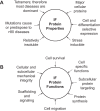Intermediate filament proteins of digestive organs: physiology and pathophysiology
- PMID: 28360031
- PMCID: PMC5495917
- DOI: 10.1152/ajpgi.00455.2016
Intermediate filament proteins of digestive organs: physiology and pathophysiology
Abstract
Intermediate filament proteins (IFs), such as cytoplasmic keratins in epithelial cells and vimentin in mesenchymal cells and the nuclear lamins, make up one of the three major cytoskeletal protein families. Whether in digestive organs or other tissues, IFs share several unique features including stress-inducible overexpression, abundance, cell-selective and differentiation state expression, and association with >80 human diseases when mutated. Whereas most IF mutations cause disease, mutations in simple epithelial keratins 8, 18, or 19 or in lamin A/C predispose to liver disease with or without other tissue manifestations. Keratins serve major functions including protection from apoptosis, providing cellular and subcellular mechanical integrity, protein targeting to subcellular compartments, and scaffolding and regulation of cell-signaling processes. Keratins are essential for Mallory-Denk body aggregate formation that occurs in association with several liver diseases, whereas an alternate type of keratin and lamin aggregation occurs upon liver involvement in porphyria. IF-associated diseases have no known directed therapy, but high-throughput drug screening to identify potential therapies is an appealing ongoing approach. Despite the extensive current knowledge base, much remains to be discovered regarding IF physiology and pathophysiology in digestive and nondigestive organs.
Keywords: Mallory-Denk bodies; intestine; keratins; lamins; liver.
Copyright © 2017 the American Physiological Society.
Figures
References
-
- Ajluni N, Meral R, Neidert AH, Brady GF, Buras E, McKenna B, DiPaola F, Chenevert TL, Horowitz JF, Buggs-Saxton C, Rupani AR, Thomas PE, Tayeh MK, Innis JW, Omary MB, Conjeevaram H, Oral EA. Spectrum of disease associated with partial lipodystrophy: lessons from a trial cohort. Clin Endocrinol (Oxf) 86: 698–707, 2017. doi:10.1111/cen.13311. - DOI - PMC - PubMed
Publication types
MeSH terms
Substances
Grants and funding
LinkOut - more resources
Full Text Sources
Other Literature Sources
Medical
Miscellaneous


